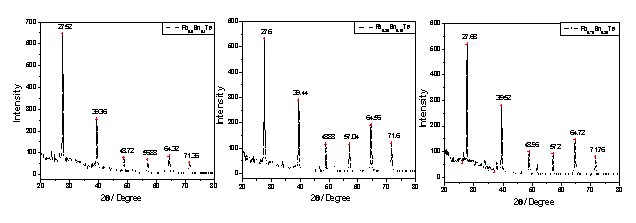

45359-AC10
Sonoelectrochemical Approach Towards Novel Nanostructured Thermoelectric Materials
Our recent research work has focused on hybrid bulk materials with nanosized TE dopants that have been prepared by a combination of sonoelectrochemical and cold pressing techniques. Furthermore, we have spent the past months on characterizing the physical and transport properties of these newly synthesized materials. This two pronged approach allows us to better understand how the nanostructuring affects the performance of TEs and enables us to develop TE materials with improved properties.
To study the modification of the thermoelectric efficiency, ZT, of bulk TE materials as a result of doping with nanoparticles, commercially available bulk PbTe powder was randomly mixed with as-synthesized PbSe nanoparticles (NPs) and pressed into pellets by cold high pressure techniques. The preliminary results indicate that the PbSe NPs are distributed randomly between bulk PbTe particles as shown in the SEM (Figure1). Furthermore transport measurements show that nanoparticle-doping leads towards modification of the transport properties of the host PbTe material.

Figure 1. SEM images of bulk PbTe pellets mixed with different amount of PbSe nanoparticles: (A), pure PbTe pellet (B), 1.0 %wt PbSe nanoparticle-doped PbTe pellet (C), 2.5%wt PbSe nanoparticle-doped PbTe pellet (D) 5.0 %wt PbSe nanoparticle- doped PbTe pellet.
However, the commercially available bulk PbTe powder shows very low electrical conductivity and carrier concentration, which results in low ZT values. To solve this problem, we synthesized our own thermoelectric bulk materials using solid synthesis techniques.
Solid synthesis of bulk TE materials:
Pb1-xSnxTe and Bi2-xSbxTe3 alloys were selected as model bulk materials because of their high electrical conductivity and the ease of modifying their carrier concentration by adjustment of their stoichiometric ratios. To make these bulk materials, appropriate amounts of Pb (99.999%), Sn (99.999%), Bi (99.999%), Sb (99.999%), and Te (99.999%) elements obtained from Sigma Aldrich, were weighed and loaded into a quartz tube. The mixture was then purged with Ar and evacuated three times to minimize oxygen contamination. The quartz tube was then vacuum sealed by oxygen flame. The sealed quartz tube was placed in an oven at the temperature used to melt the powder for 5 hr. During the annealing process, the quartz tube was rotated every twenty minutes.

Figure 2. The powder x-ray diffraction pattern of the synthesized
bulk Pb1-xSnxTe (x=0.1,0.15,0.25) TE materials.
 |
Figure 3. The powder x-ray diffraction pattern of the synthesized
bulk Bi2-xSbxTe3 (x=0.1,0.15,0.25) TE materials.
The powder x-ray diffraction patterns (Figures 2, 3) of the prepared samples show that the synthesized bulk materials match standard data, and the peak shifts as the stoichiometric ratio changes, which is a characteristic property of alloying. The bulk materials have been ground into powder and pressed into pellets by high pressure at room temperature. The preliminary electrical conductivity and carrier concentration data in Table 1 shows that the prepared bulk materials have significant transport properties improvement compared to the commercially available PbTe powder obtained from Sigma Aldrich.
Table 1. The carrier concentrations, resistivities and Hall mobilities of the pellets made from the synthesized bulk materials.
Sample | Carrier conc. ×1024 m-3 | Resistivity mWm | Hall mobility m2/V*s |
Pb0.85Sn0.15Te | 2.37 | 164 | 0.0161 |
Bi0.5Sb1.5Te3 | 51.8 | 7.76 | 0.0155 |
PbTe (from Aldrich) | 0.13 | 3000 | 0.09 |
in situ Grown PbSe nanostructured thermoelectric films:
Thermoelectric transport measurements indicate that the power factor (S2σ) and electrical conductivity (σ) of the in situ grown PbSe thin films are dependent on the morphological changes of the thin films, which are highly related to the pH of the solution (Figure 4). The prepared PbSe thin films show improved Seebeck coefficients compared to the same carrier concentration from single crystal PbSe.

Figure 4. Seebeck coefficient as a function of hole concentration for PbSe single crystals (blue open squares), monocrystalline thin films (blue open circles), and synthesized PbSe thin films (red filled circles). The solid line is a theoretical prediction for bulk PbSe assuming phonon scattering is the dominating factor.